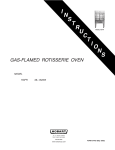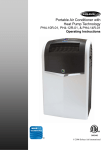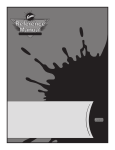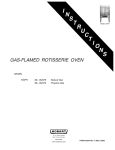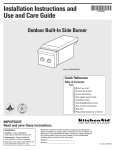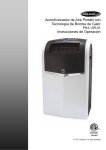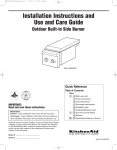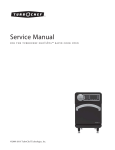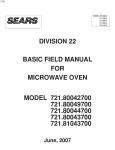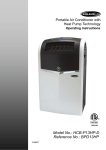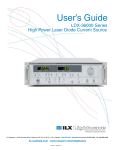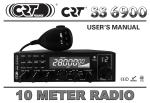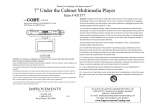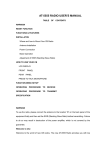Download NN-A574SBBTQ NN-A554WBBTQ NN-A524MBBTQ
Transcript
HAD0608002C2 Microwave Oven NN-A574SBBTQ NN-A554WBBTQ NN-A524MBBTQ Power source 230-240VAC Single Phase 50Hz Power requirements Microwave 1180W Grill 1380W Convection 1390W Micro / Grill Combi 2380W Micro / Conv Combi 2390W Output (IEC60705) Microwave 1000W Grill 1300W Convection 1300W Microwave frequency 2450 Mhz Timer 99 min 99 second Oven cavity size 27L Outside dimensions 510mm(W) x 390mm(D) X 305MM (H) Inside dimensions 359mm(W) X 352mm(D) x 217mm(H) Weight 13Kg Specifications subject to change without notice ! WARNING This service information is designed for experienced repair technicians only and is not designed for use by the general public. It does not contain warnings or cautions to advise non-technical individuals of potential dangers in attempting to service a product. Products powered by electricity must be serviced or repaired only by experienced proffesional technicians. Any attempt to service or repair the product or products dealt with this service information by anyone else could result in serious injury or death. IMPORTANT SAFETY NOTICE There are special components used in this equipment which are important for safety. These parts are marked by (!) in the schematic diagrams, circuit board diagrams, exploded views and replacement parts lists. It is essential that these critical parts are replaced with parts specified by the manufacturer, preventing shock, fire or other hazards. Do not modify the original design without permission from the manufacturer. 1 Contents 1 Contents . . . . . . . . . . . . . . . . . . . . . . . . . . . . . . . . . . . . . . . . . . . . . . . . . . . . . . . . . . 2 2 Feature Chart . . . . . . . . . . . . . . . . . . . . . . . . . . . . . . . . . . . . . . . . . . . . . . . . . . . . . . 3 3 Control Panel . . . . . . . . . . . . . . . . . . . . . . . . . . . . . . . . . . . . . . . . . . . . . . . . . . . . . . 4 4 Inverter Warnings . . . . . . . . . . . . . . . . . . . . . . . . . . . . . . . . . . . . . . . . . . . . . . . . . . 5 5 Oven Schematic . . . . . . . . . . . . . . . . . . . . . . . . . . . . . . . . . . . . . . . . . . . . . . . . . . . . 6 6 Wiring Diagram . . . . . . . . . . . . . . . . . . . . . . . . . . . . . . . . . . . . . . . . . . . . . . . . . . . . 7 7 Description of Operation . . . . . . . . . . . . . . . . . . . . . . . . . . . . . . . . . . . . . . . . . . . . . 8 8 Cautions when Troubleshooting. . . . . . . . . . . . . . . . . . . . . . . . . . . . . . . . . . . . . . . . 9 9 Part Replacement Procedure . . . . . . . . . . . . . . . . . . . . . . . . . . . . . . . . . . . . . . . . . . 12 10 Component Test Procedure . . . . . . . . . . . . . . . . . . . . . . . . . . . . . . . . . . . . . . . . . . . 15 11 Measurements and Adjustments . . . . . . . . . . . . . . . . . . . . . . . . . . . . . . . . . . . . . . . 17 12 Troubleshooting Guide . . . . . . . . . . . . . . . . . . . . . . . . . . . . . . . . . . . . . . . . . . . . . . . 18 13 Parts List . . . . . . . . . . . . . . . . . . . . . . . . . . . . . . . . . . . . . . . . . . . . . . . . . . . . . . . . . 24 14 Exploded View . . . . . . . . . . . . . . . . . . . . . . . . . . . . . . . . . . . . . . . . . . . . . . . . . . . . . 26 15 Door Assy . . . . . . . . . . . . . . . . . . . . . . . . . . . . . . . . . . . . . . . . . . . . . . . . . . . . . . . . . 27 16 Escutcheon Base. . . . . . . . . . . . . . . . . . . . . . . . . . . . . . . . . . . . . . . . . . . . . . . . . . . . 29 17 Packing and Accessories . . . . . . . . . . . . . . . . . . . . . . . . . . . . . . . . . . . . . . . . . . . . . 31 18 Digital Programmer Circuit. . . . . . . . . . . . . . . . . . . . . . . . . . . . . . . . . . . . . . . . . . . . 32 2 2 Feature Chart Function All Models Microwave 6 Grill 3 Convection 13 Combi Yes Weight reheat 4 Weight cook 2 Weight combination 1 Weight defrost 3 Auto Preheat 3 Delay/Stand Yes Kg/lb Yes Stage Cooking 3 Clock 12 h Word prompt English 3 3 Control Panel Control Panel NN-A554/A524/A574* (1) (2) (3) (1) AUTO REHEAT Curry Chinese 1 h 10 min 1 2 1 min 10 sec 3 4 Micr o Power 5 6 Fish Veg 7 Jacket Potatoes 8 Potato Products 9 Chicken (2) (3) Pasta Casserole AUTO COOK (6) (7) (8) (9) Grill 1-2-3 Convection Combination (5) (10) Delay/ Stand Clock 10 Pizza lb oz up down (11) (14) Stop/Cancel Start NN-A554W Display Window Time Pads Auto Weight Microwave Programs (4) Auto Weight Combination Programs (5) Auto Weight Defrost Programs (Chaos Defrost) (6) Microwave Power Pad (7) Grill Pad (8) Convection Pad (9) Combination Pad (10) Delay/Stand Pad: This can be used to delay a cooking program for up to 9 hrs 99 mins., or used to time or for standing (noncooking) time. (11) Clock Pad (12) lb/oz Conversion Pad (13) Weight Selection Pads (4) (14) Stop/Cancel Pad: Before Cooking: one press clears your instructions. During Cooking: one press temporarily stops the cooking program. Another press (12) cancels all your instructions and the time of day will appear in the display. (13) (15) Start Pad: Press to start operating the oven. If (15) during cooking the door is opened or Stop/Cancel Pad is pressed once, Start Pad has to be pressed again to continue cooking. The design of your control panel may vary from the panel displayed (depending on colour), but the words on the pads will be the same. Beep Sound: A beep sounds when a pad is pressed. If this beep does not sound, the setting is incorrect. When the oven changes from one function to another, two beeps sound. After completion of cooking, five beeps sound. 4 4 Inverter Warnings The inverter circuit board supplies the magnetron tube with a very high voltage (4000 volts). HIGH VOLTAGE AREA *1 HEAT SINK RECTIFIER BRIDGE DO NOT TOUCH HOT/HIGH VOLTAGE *2 FILM CAPACITORS CHOKE COIL SAND BAR RESISTOR HIGH VOLTAGE DIODES CURRENT TRANSFORMER PRESET VOLUME *4 (DO NOT ADJUST) HIGH VOLTAGE CAPACITORS CONTROL BOARD WITH CUSTOM IC PHOTOCOUPLER CN 703 CN 701 HIGH VOLTAGE TRANSFORMER Danger • The inverter circuit board operates at high voltages and high temperatures. The Inverter PCB • • • Operates at a very high voltage and current. Has an aluminium heat sink which becomes very hot. Has capacitors in the circuitry that hold a high voltage charge even when the oven is not operating. Warning • Do not touch the high voltage circuit. When replacing the board care must be taken to avoid possible electric shock. • Do not touch the aluminium heat sink as it is part of the high voltage circuit and becomes very hot. • Do not attempt to repair the inverter PCB, this can be very dangerous. Replace the high voltage inverter circuit as a complete unit. • Do not adjust or tamper with the pre-set volume on the inverter board. It is very dangerous to adjust this pre-set without proper test equipment. • Do not operate the microwave oven when the inverter grounding plate and fixing screw is loose. It is very dangerous to operate the inverter circuit board without a proper ground connection. figure 1Assembly of the inverter circuit board 5 5 Schematic Diagram 6 6 Wiring Diagram BR OR 1 C2 (N) NOTE WHEN REPLACIN ANY COMPONENT S RECONNECT THE WIRE HARNESS ACCORDIN T O THE COLOURS BELOW COL OURS INDICATED INSIDE BRACKETS () INDICATE THE COLOUR O THE CONNECTOR HOUSIN BR MA NETRON BR PRIMARY LATCH SWITCH TOP (WH) WH BR (YE) CAUTION HEAT SINK (HOT LI E) ER Y HI H OL TA E AND TEMPERATURE YE R WH SECONDARY LATCH SWITCH BOTTOM OUTSIDE SHORT SWITCH BOTTOM INSIDE HI H OL TA E IN ER TER 21 (N) SYMBOL BL BK BR WH YE N R BL YE BL POWER RELAY (RY1) 7 COLOUR BLUE BLACK BROWN WHITE YELLOW NATURAL RED R 7 Description of the Operating Sequence 7.1 Variable power cooking control pad pressed: The output power is controlled by the inverter power supply. The level of output from the inverter circuit is controlled by a pulse width modulated signal from the digital programmer circuit (DPC). The digital programmer circuit operates relay RY1 to supply power to the inverter circuit. 1. The digital programmer circuit determines the power level and the cooking time and indicates the operating state in the display. The table shows the corresponding cooking times and weights for the selected category. 2. When the cooking time in the display window has elapsed, the oven turns off automatically via the control signal from the digital programmer circuit. NOTE: If the microwave cooking time is longer than 3 minutes, the cooling fan will operate for 1 minute to cool the oven and its electronic components. Note: After auto cooking if the oven temperature is over the predetermined temperature the fan motor rotates to cool the oven and its components. 7.2 Auto weight defrost, Auto weight Cook When an auto control feature is selected and the start Auto weight defrost Category Bread Meat items Meat joints 1st Touch weight 100g 200g 400g Cooking time 0 Min 45 Sec 2 Min 40 Sec 8 Min 20 Sec Auto Weight Cook Category 1. 2. 3. 4. 5. 6. Curry Chinese Style Pasta Casserole Fresh Vegetables Fresh Fish 1st Touch weight 300g 200g 250g 300g 100g 100g 8 Cooking time 3 2 2 3 2 1 Min Min Min Min Min Min 30 10 55 15 20 30 Sec Sec Sec Sec Sec Sec 8 Cautions to be Observed when Troubleshooting The microwave oven is a high voltage, high current device. Although it is free from danger in ordinary use, extreme care should be taken during repair. This high voltage inverter power supply supplies very high voltage and current to the magnetron. Though it is free from danger in ordinary use, extreme care should be taken during repair. This circuit looks like a TV flyback transformer, however, the currents and voltages in this circuit are very high, this means this circuit is extremely dangerous. Caution: Servicemen should remove their watches whenever working close to or replacing the magnetron. 8.1 Check the grounding The aluminium heat sink is also energized with high voltage, never touch this heat sink when the microwave oven is plugged into the mains outlet. The collector of the power device (IGBT) is directly connected to the aluminium heat sink. Do not operate the microwave oven on a two wire extension cord. The microwave oven is designed to be used only when grounded. It is imperative that the appliance is properly grounded before beginning repair work. The aluminium heat sink becomes very hot when the inverter circuit operates. Never touch this heat sink during operation and allow time for it to cool down before servicing the microwave oven. 8.2 Inverter Warnings DANGER, HIGH VOLTAGE AND HIGH TEMPERATURES ON THE INVERTER POWER SUPPLY DANGER HIGH VOLTAGE AND TEMPERATURE (HOT/LIVE) HEAT SINK HEAT SINK RECTIFIER BRIDGE CHOKE COIL FILM CAPACITORS SAND BAR RESISTOR HIGH VOLTAGE DIODES CURRENT TRANSFORMER PRESET VOLUME (DO NOT ADJUST) HIGH VOLTAGE CAPACITORS CONTROL BOARD WITH CUSTOM IC PHOTOCOUPLER CN 701 CN 703 HIGH VOLTAGE TRANSFORMER HIGH VOLTAGE REMAINS IN CAPACITORS figure 3 HV Inverter warning WARNING INVERTER POWER SUPPLY GROUNDING Check the high voltage inverter power supply circuit grounding. The high voltage inverter circuit board must be connected to the microwave oven chassis. If the inverter board is not grounded it exposes very high voltages and causes extreme DANGER! Ensure that the inverter circuit is properly grounded via the inverter earth bracket. 9 work on or near these inverter circuit components. DO NOT measure the voltage in the high voltage circuit including the filament voltage of the magnetron. WARNING Never touch any circuit wiring during operation. 8.3 Part replacement When replacing any component in the microwave oven, always ensure that the power cord is removed from the wall outlet. 8.4 When the 10A fuse is blown due to the operation of the short switch Earth Bracket WARNING Always replace both the short switch and the primary latch switch when the 10A 250V fuse is blown due to the operation of the short switch. It is also important to change the power relay 1 (RY1) when the continuity test shows shorted contacts. figure 4 Grounding of the inverter circuit board WARNING! DISCHARGE THE HIGH VOLTAGE CAPACITORS For about 30 seconds after the oven is turned off, an electric charge remains in the high voltage capacitors on the inverter circuit board. 1. This is mandatory. Refer to “adjustments and measurements” for the location of these switches. 2. When replacing the fuse, confirm that it has the appropriate rating for these models. 3. When replacing faulty switches, be sure the mounting tabs are not bent, broken or deficient in their ability to hold the switches. 8.5 Oven cavity aperatures Never insert a wire or any other metal object through the lamp holes or other aperatures in the oven cavity, because such objects may work as an antenna and cause microwave leakage. 8.6 Confirm after repair 1. After repair or replacement of parts, make sure that the screws of the oven are neither loose nor missing. Microwaves might leak if screws are not properly tightened. 2. Make sure that all electrical connections are tight before inserting the plug into the wall outlet. 3. Check for microwave energy leakage. (Refer to proceedure for measuring microwave energy leakage). figure 5 Discharging the high voltage capacitors 1. Before replacing or testing parts discharge these high voltage capacitors by shorting the inverter ouput terminal to the microwave oven chassis 2. Remove the power plug from the mains outlet 3. Ensure that the high voltage lead is connected to the inverter output terminals and the magnetron input terminals. 4. Short the magnetron input terminal to the microwave oven chassis using an insulated handle screwdriver. 5. Always touch the microwave oven chassis and then the magnetron terminal. CAUTION MICROWAVE ENERGY Microwave energy is emitted from the magnetron attenna into the oven cavity via the wave guide. Do not opearate the microwave oven if the door is defective, the magnetron is not fitted correctly or the outer panel is removed. IMPORTANT NOTICE When the microwave oven is operating the following components carry a potential above 240VAC. • • • • WARNING There is high voltage with high current capabilities in the primary, secondary windings, choke coil and heat sink on the inverter circuit. When power is connected to the microwave oven, it is extremely dangerous to Magnetron High voltage transformer (Located on inverter) High voltage diodes (Located on inverter ) High voltage capacitors (Located on inverter ) Pay special attention in these areas. 10 When the appliance is operated with the door hinges or magnetron fixed incorrectly, the microwave leakage can reach more than 5mW/cm3. After repair or replacing parts, it is very important to check if the magnetron and the door hinges are correctly fixed. 8.7 Sharp edges Please use caution when unpacking, installing or moving the unit, as some exposed edges may be sharp to touch and cause injury if not handled with care. 11 9 Part Replacement Procedure 9.1 Magnetron 4. Remove the 1 screw holding the earth wire to the magnetron. 5. Remove the connector CN701 and CN702 from the inverter PCB.figure 8 6. Remove the 2 screws holding the inverter supportbase to the oven chassis. 7. Carefully remove the inverter circuit board and support base from the oven. 8. Remove the air guide E. 9. Remove the 4 screws holding the inverter circuit board to the inverter support base. Figure 7 1. Discharge the high voltage capacitors on the inverter circuit. 2. Remove the 1 screw holding air guide A. 3. Remove the 2 screws holding the tie bar. 4. Remove the oven lamp and lead wire harness from air guide A. 5. Remove the air guide A. 6. Disconnect the 2 high voltage leads from the magnetron. 7. Remove the 4 screws holding the magnetron. Caution NOTE: After replacing the magnetron, tighten the mounting screws so there is no gap between the waveguide and the magnetron, this prevents microwave leakage. When replacing the inverter circuit 1. Check the grounding plate is in place. 2. Securely tighten the grounding plate screw through the side of the oven chassis. 3. Connect the 3 lead wire plugs into the correct sockets. 4. Ensure there is enough space between the heat sink and other components. Check that no lead wires are touching the aluminium heat sink. Caution When replacing the magnetron, ensure that the antenna gasket is in place. Note The magnetron used for this model is unique for the inverter power supply system. Only fit the magnetron listed in the service manual parts list. figure 7 Removal of the inverter PCB. AIR GUIDE A figure 6 Removal of the magnetron 9.2 Inverter circuit 1. Discharge the high voltage capacitors. 2. Remove 2 screws holding the tie bar. 3. Unplug the H.V. Lead wires from the magnetron. figure 8 Disconnecting the PCB locking plug. 12 9.3 Digital Programmer Circuit (DPC) and membrane key board. 1. Carefully remove all solder from the terminal pins of the low voltage transformer / power relays using a 30W soldering iron and a solder sucker. 2. With all of the terminal pins cleaned and separated from the DPC contacts, remove the defective transformer / power relays and install the new components making sure that the terminal pins are inserted completely. Carefully re-solder all terminal contacts carefully. NOTE: Ground any static electric from your body before handling the digital programmer circuit (DPC). 1. Disconnect all lead wire plugs from the DPC. 2. Release the ribbon cable from the DPC. 3. Remove 2 screws holding the escutcheon base to the microwave oven chassis. To remove the escutcheon base; open the microwave oven door and slide the escutcheon base upward slightly. 4. Remove the 6 screws holding the DPC DU assembly. 5. Remove the door lever. 6. Remove the 7 screws holding the DPC AU assembly. Do not use a soldering iron of more than 30 watts on DPC contacts To remove escutcheon pad. 9.5 Fan Motor 1. Remove the escutcheon bracket from the escutcheon base by freeing the 4 catch hooks. 2. Peel away the display window from the inside of the base. 3. Remove the membrane assembly by pushing from the inside of the base and then peeling it away from the outside surface. 1. Remove 2 screws to remove the tie bar. 2. Disconnect the 2 lead wires from the fan motor terminals. 3. Disconnect all lead wires from the noise filter. 4. Remove the noise filter. 5. Remove 2 screws to remove cover B. 6. Remove 2 screws holding the orifice assembly. 7. Remove 2 screws holding the fan motor assembly. 8. Detatch the orifice assembly and the fan motor assembly from the microwave oven. 9. Remove the fan blade from the fan motor by pulling outward. Note NOTE: 1. When installing a new escutcheon key board, make sure that the surface of the escutcheon base is cleared, avoiding problems such as shorted contacts and uneven surfaces. 2. When replacing a stainless / aluminium escutcheon assembly, ensure that the stainless facia is earthed to the escutcheon back plate via the earth spring. DPC DU DPC AU figure 10 Removing the fan motor. 9.6 Door replacement 1. Carefully lever door C away from Door E using a flat blade screwdriver. 2. Remove 4 screws holding the door E to the door A assembly. 3. Remove the door screen B by unclipping the screen B from the door A catch hooks. Take care when removing the door screen B from door A, it is possible to damage the catch hooks on the door A . 4. Remove the door key and spring from the door E. figure 9 Removal of DPC AU and DPC DU 9.4 Low voltage transformer and / or power relays (RY1) Note Ground your body to discharge static charges before handling the DPC. 13 After replacing component parts of the door, follow the instructions below for proper installation and adjustment of the door, this is to prevent microwave leakage. 1. When mounting the door to the oven, adjust the door parallel to the bottom of the oven face plate by adjusting the upper hinge. 2. Adjust the door so there is no play between the inner door surface and the front of the microwave oven. If the door assembly is not mounted properly, microwave energy may leak from the clearance between the door and microwave oven. 3. Perform the microwave leakage test. DOOR A DOOR SCREEN B DOOR E figure 13 Removing the turntable motor cover. DOOR HOOK SPRING DOOR C figure 11 Disassembly of the door. figure 12 Adjusting the door hinge. figure 14 Removing the two screws fixing the turntable motor. 9.7 Turntable Motor 9.8 1. Remove the motor cover by breaking it off at the 8 spots indicated by the arrows. 2. Disconnect the two lead wires connected to the turntable motor. 3. Remove the 2 screws holding the turntable motor. Pulley Mechanism 1.) Remove the Pulley Belt and Heater Hood. 2.) Remove Pulley A by releasing the nut and removing the washer. 3.) Remove the Thermistor screw and re-position the thermistor cable so as not to interfere. 4.) Remove the screw securing the Motor Bracket and manouvre the fan cover from its housing. Note: After breaking off the motor cover, make sure no sharp edges are exposed by trimming off the edges or bending them inside. Note: To secure the motor cover use a 4 x 6 screw. 14 10 Component Test Procedure Caution • • • 3. Check the continuity between each filament terminal and the magnetron case, a good magnetron The inverter circuit operates at high voltages. Never attempt to measure the high voltage on the inverter circuit. Before touching any oven components, or wiring, always unplug the oven from its power source and discharge the high voltage capacitors. indicates infinite ∞ resistance. 10.1 Primary latch switch, secondary latch switch and power relay B interlocks. 1. Unplug the lead wires from the contact terminals of RY1, check the continuity across these terminals using an ohm meter set to the lowest resistance scale. 2. Unplug the lead wires to the primary latch switch and secondary latch switch. 3. Test the continuity of each switch with an ohm meter set to the lowest resistance scale. The test must be completed with the microwave oven door open and closed. 4. Normal continuity readings should be as follows. Door Open Door Closed Primary Latch Switch ∞ Ω (Open) 0 Ω (Close) Secondary Latch switch ∞ Ω(Open) 0 Ω (Close) Power relay B ∞ Ω(Open) ∞ Ω (Close) figure 15 Testing the magnetron 10.4 Push button keyboard Check the continuity between the switch terminals on the DPC AU, by tapping an appropriate pad on the keyboard and measuring the resistance across the corresponding tracks on the ribbon cable. 10.5 Inverter power supply Caution 10.2 Short switch and monitor circuit DO NOT try to repair this inverter power supply. Replace this inverter power supply as a unit. 1. Unplug the lead wires from the high voltage inverter primary terminals. 2. Connect the test probes of the ohm meter to these leads. 3. Test the continuity of the short switch with the door open and the door closed using a ohm meter set to the lowest resistance scale. Door Open Monitor switch 0 Ω Door Closed ∞Ω 10.3 Magnetron Continuity checks can only indicate an open filament or a shorted magnetron. To diagnose an open filament or shorted magnetron: 1. Disconnect the high voltage lead wires from the magnetron input terminals. 2. Check the continuity across the magnetron filament terminals, a good magnetron indicates a resistance of 1 ohm or less. 15 DANGER HIGH VOLTAGE AND TEMPERATURE (HOT/LIVE) HEAT SINK HEAT SINK RECTIFIER BRIDGE CHOKE COIL FILM CAPACITORS SAND BAR RESISTOR HIGH VOLTAGE DIODES CURRENT TRANSFORMER PRESET VOLUME (DO NOT ADJUST) HIGH VOLTAGE CAPACITORS CONTROL BOARD WITH CUSTOM IC PHOTOCOUPLER CN 701 CN 702 HIGH VOLTAGE TRANSFORMER HIGH VOLTAGE REMAINS IN CAPACITORS figure 16 Inverter circuit board layout 10.6 Inverter power supply unit Warning Do not attempt to make any measurements in the high voltage circuit of the inverter or magnetron. See troubleshooting of the inverter circuit and magnetron on <$elemtextto determine if the inverter power supply is still functioning. 16 11 Measurements and Adjustments Warning • • • • 4. Stir the water again and read the temperature of the water. (Record as T2). 5. The normal temperature rise at the high power position for each model is shown in the table figure 18 Only replace parts with parts from the original manufacturer. When the 10 amp fuse is blown due to the operation of the short switch, you must replace the primary latch switch and short switch. Then follow the installation procedures below. Interlock switch replacement - When replacing faulty switches, check the mounting tabs on the door-hook assembly are not bent, broken or deficient in their ability to hold the switches. Refer to the schematic and wiring diagram to ensure the plug connectors on the wire harness are connected to correct switches. SCREW PRIMARY LATCH SWITCH 11.1 Installation of primary latch switch, secondary latch switch and short switch. SHORT LATCH SWITCH SECONDARY LATCH SWITCH 1. When mounting the primary latch-switch, secondary latch-switch and short latch-switch to the door hook assembly. Follow the instructions in <$elemtextfigure 17. 2. NOTE: No specific adjustment during the insulation of each switch into the door hook is necessary. 3. When mounting the door hook assembly to the oven assembly, adjust the door hook assembly by moving it in the direction of the arrow figure 17. Ensuring the door does not have any play in it. Check for play by pulling the door assembly. Make sure that the latch keys move smoothly after adjustment is completed. Completely tighten the screws holding the door hook assembly to the oven assembly. 4. Reconnect the short switch, primary switch and secondary latch switches and check the continuity of the monitor circuit and latch switches by following the component test procedures on <$elemtext. SWITCH SWITCH GAP < 0.7mm ACTUATOR LEVER figure 17 Adjustment of latch switches RATED OUTPUT 1000W 11.2 Measurement of microwave output figure 18 Temperature rise The output power of the magnetron can be determined by performing the IEC standard test. However, due to the complexity of the IEC test procedures, it is recommended you test the magnetron using the simple method outlined below. Necessary equipment: • • • 1 litre beaker. Glass thermometer. Wrist watch or stop watch. NOTE: Check the line voltage under load. Low line voltage lowers the magnetron output. Take the temperature readings and heating time as accurate as possible. 1. Fill the beaker with exactly one liter of tap water. Stir the water using the thermometer and record the waters temperature (Record as T1). 2. Place the beaker on the center of the glass cook plate. 3. Operate the microwave for 1 minute on FULL power. 17 TEMPERATURE RISE 8°C (Degrees centigrade) 12 Troubleshooting Guide Caution 1. Do not try to repair the H.V. Inverter power supply. Replace the inverter circuit board as a complete unit. 2. Do not adjust the preset volume on the Inverter. It is very dangerous to repair or adjust without special test equiptment, the inverter handles very high voltage and current. 3. Do not attempt to measure the voltages in the microwave oven high voltage circuit. 4. Always discharge the high voltage capacitors on the inverter circuit board before troubleshooting. 5. When checking the continuity of the components on the H.V. Inverter circuit, unsolder and remove one leg of the component from circuit board. Checking the continuity of these components when both legs are soldered into the board may result in a false reading or damage to your meter. 6. When disconnecting a plastic connector from a terminal, you must hold the plastic connector and not the lead wire, otherwise the lead wire may become open circuit. 7. Do not touch components on the digital programmer circuit, this circuit is sensitive to static electricity. 8. When working with the digital programmer board ensure your body is connected to ground to discharge any static charge. 9. 240 VAC is present on the digital programmer circuit. (Terminals of the power relays and the primary circuit of the low voltage transformer). When troubleshooting, be cautious of possible electric shock. To ensure the complaint is not due to operator error, check the operation of the oven by following the procedures explained in the operating instruction book. 18 12.1 Troubleshooting (no operation) Symptom Cause Correction 1. Oven is dead. Fuse is OK No display and no operation at all. 1. Open or loose lead wire harness. 2. Open low voltage transformer. 3. Defective DPC AU or DPC DU 2. Oven does not accept key input (Program). 1. Key input is not in sequence. 2. Shorted push button on DPC AU 3. Defective DPC AU. Refer to operation procedure. Refer to DPC troubleshooting 3. Oven lamp and turntable motor turn 1. Maladjusted or loose wiring of Adjust door and latch switches. on when the microwave oven is secondary latch switch. plugged in with the door closed. 2. Defective secondary latch switch. 4. Timer starts to countdown but no microwave oscillation. 1. Maladjusted latch switches. Adjust door and latch switches. 2. Open or loose connection of high voltage circuit, including the magnetron filament circuit. NOTE: A large contact resistance lowers the magnetron filament voltage reducing the magnetron output or causing intermittent operation. 3. Defective high voltage component Inverter circuit or Magnetron. Check high voltage components 4. Open or loose wiring of power according to the component test relay (RY1) procedure. 5. Defective primary latch switch. 6. Defective power relay RY1 or DPC AU or DPC DU. 12.2 Troubleshooting (fuse blown) Symptom 1. No display and no operation at all. 10A Fuse is Blown Cause Correction 1. Shorted lead wire harness. Check adjustment of the Door, Pri2. Defective primary latch switch mary, secondary and short latch (NOTE 1) switches. 3. Defective short switch (NOTE 1) 4. Defective Inverter power supply. (Refer to inverter circuit test procedure on page) NOTE 1: All of these switches must be replaced at the same time. (Refer to adjustment instructions page) Check continuity of power relay RY1 Replacce this relay if it is short circuit. 19 12.3 Troubleshooting (other problems) Symptom Cause Correction 1. Microwave output is low. 1. Decrease in power source voltConsult electrician. Refer to output test procedures. Oven takes a long time to cook food. age. 2. Open or loose wiring of magnetron filament circuit causing interChange magnetron mittent oscillation. 3. Ageing of magnetron 2. Loud Buzzing noise can be heard. 1. Loose fan or fan motor 3. Turntable motor does not rotate. 1. Open or loose wiring of turntable motor. 2. Defective turntable motor 4. Oven stops operation during cooking 1. Open or loose wiring of primary cycle. and secondary latch switch. 5. Oven returns to “plug in” state 9 seconds after the start pad is pressed in sensor cooking mode. Adjust door and latch switches. 1. Open steam sensor circuit. 2. Defective steam sensor. 12.4 Troubleshooting the inverter by input voltage Troubleshooting the Inverter circuit and magnetron Microwave oven shuts down between 15 - 33 seconds. If the microwave oven shuts down after a short period of time while operating in micropower mode, conduct the following test. The microwave oven must be set in self test mode to activate the self diagnostic failure code system. Stop/Cancel Delay/ S tand Micro Power Start When oven is set in test mode, place water load (1Ltr) in the oven, set micropower to high and time for 1 minute, press start. H97, H98 appears in the display window for a short time after start key is pressed and there is no microwave oscillation. 20 DANGER HIGH VOLTAGE H97, H98 appears in the display window. Check magnetron filament continuity Open Magnetron* OK Check Inverter input AC voltages at CN702 AC 240V *Check the continuity of the magnetron filament. Check the fialment is not shorted to the magnetron case.. DPC board/Power relay Loose relay wiring Latch switch 0V Unplug CN702 and test for 240VAC across the lead wire connector. Check Inverter control 0V signal at CN701 Pin 1 and 2 Unplug CN702 and test for Approx AC 3V 3 VAC acorss the lead wire connector. DPC board H.V. Inverter NOTE: NOTE: DO NOT try to REPAIR the inverter power supply. DO NOT ADJUST THE PRESET VOLUME on the inverter circuit board. It is very dangerous to repair or adjust this preset without correct test equipment. Do not attempt to repair the inverter circuit board, replace the inverter circuit board with a new unit. 12.5 Troubleshooting inverter by microwave oven input current This is an alternative way to test the inverter circuit by monitoring the input current to the microwave oven. The microwave oven shuts down between 15 and 33 seconds If the microwave oven shuts down after a short period of time while operating in micropower mode, conduct the following test. The microwave oven must be set in self test mode to activate the self diagnostic failure code system. Stop/Cancel Delay/ S tand Micro Power Start When the microwave oven is set in test mode, place a water load (1Ltr) in the oven, set micropower to high and time to 1 minute, press start. A short time after the start pad is pressed, H97, H98 appears in the display window and the magnetron does not oscillate. 21 DANGER HIGH VOLTAGE H97, H98 appears in the display window. DPC board/Power Relay Less than 0.4A Loose wiring. Latch Switch. DPC control signal More than 0.5A Check oven input current. Open Check magnetron filament continuity. OK Magnetron* Refer to component test procedures Stop!! If all the previous checks are OK, there may be an H.V. Inverter fault. NOTE: *Check the continuity of the magnetron filament. Check the filament is not shorted to the magnetron case. NOTE: DO NOT try to REPAIR the inverter power supply. DO NOT ADJUST THE PRESET VOLUME on the inverter circuit board. It is very dangerous to repair or adjust this preset without correct test equipment. Do not attempt to repair the inverter circuit board, replace the inverter circuit board with a new unit. 12.6 Digital programmer circuit troubleshooting SYMPTOM STEP CHECK RESULT CORRECTION No display when the microwave oven is first plugged in. 1 Fuse pattern on DPC Normal STEP 2 Open (Note1) Shorted circuit ZNRLVT-Lamp Microwave oven is dead 2 3 4 IC10 pin 9 12V line Abnormal 0V IC10 Normal 12V Step 3 IC-1 pin 73 (Emitter of Q10) Abnormal ZB10 Q10 Ribbon cable Normal 5V Step 4 IC-1 pin 27 (pin 15 of IC220) Abnormal IC-220 Normal IC1 CX1 NOTE The procedure for repairing the fuse pattern on the DPC is as follows: 1. Fuse pattern PF2 open circuit a) Remove the jumper wire PF2 b) Move the jumper wire PF3 into the postion of PF2 and solder inplace. Replace the DPC if both the fuse pattern PF2 and PF3 are open circuit. Note: After repairing the fuse pattern on the DPC, check the varistor for any burns and measure the winding resistance of the low-voltage transformer primary coil. No key input 1 Push button switch No beep sound 1 IC1 pin 12 Power relay (RY2 ) does not operate 1 IC-1 pin 23 during operation Abnormal 2 Create a short circuit between pin 6 and pin 16 of IC-2 RY2 does not turn on RY2 RY2 turns on IC-220 IC-1 pin 18 and 16 during high power operation Abnormal IC-1 Normal 18 - 5V 16 - 5V Step 2 Abnormal Display No microwave oscillation Dark or unclear display Missing segments in display 1 2 Q221 transistor 1 Replace display Replace IC-1 22 Abnormal Push button switch Normal IC-1 Abnormal IC-1 Normal IC-220 BZ310 Normal 5V Normal IC-1 Abnormal IC-1 Normal Display Microwave oven shuts down between 15 - 33 seconds. Set the microwave oven to test mode Set to high power 1 minute. H97 or H98 appears in the display and the microwave oven stops working Program for 1 minute and perform the following test 1 Unplug CN702 connec- Abnormal tor and measure the voltage between the Normal terminlas 2 1. Latch switch 2. DPC/Power relay Step 2 Unplug CN703 connec- Abnormal tor and measure the Normal voltage at Pin 1 DPC 1. Magnetron 2. Inverter circuit 12.7 Checking the semiconductors using a resistance meter Diode A K A K Forward A-K Reverse Low Transistor C Forward B E B-E Low B-C Low Reverse C-E C Forward B E E-B Low C-B Low Reverse C-E Digital transistor EC B E C E-B 10 -30 k B C-B 50 -90 k C-E 40 -60 k Forward 23 Reverse 10 -30 k























